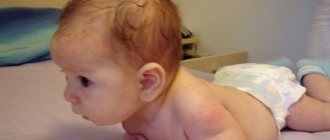The baby grows, raises its head, tries to roll over - all this pleases loving parents who proudly watch the growth of the baby. At this time, parents begin to worry about the question: at what month does the child begin to crawl. There are generally accepted standards for the motor activity of infants in the first year of life.
The normal age to start crawling is 7-8 months. It is impossible to say exactly from which month a child should start crawling. Each baby is different, so some may start crawling at 5 months, others will take up this interesting activity closer to 9 months of life.
Sometimes the baby skips the crawling stage and immediately stands on his feet, which parents are very proud of. Experts believe that skipping the crawling stage negatively affects the formation of the baby’s skeleton. The process of crawling strengthens the baby's muscles and vertebrae, and develops spatial thinking and coordination in young children.
What are the benefits of crawling for a baby?
The first step to the baby’s independence, to understanding the surrounding space. Develops curiosity and determination. Gives you confidence in your own abilities. Having learned to crawl, the baby will open up new possibilities for itself and begin to develop more intensively.
Intellectual development. The first year of a baby’s life is characterized by the fact that motor activity is closely related to the mental and emotional development of the infant. The more active the child is, the better the blood supply to the brain. Movement is interconnected with the development of speech and ensures coordination between the left and right hemispheres of the brain.
Strengthening muscles and spine. During crawling, the muscles of the limbs are involved, as well as the back, physical activity on which correctly develops the curves of the spine and strengthens the muscles themselves. When crawling on your belly, when the legs are spread apart, hip dysplasia is prevented. Active strengthening of all muscle groups naturally corrects increased and decreased muscle tone, torticollis, and body asymmetry.
Formation of coordination of body movement. Maintaining balance, orienting in space - all this can be done by the skill of coordination.
Crawling is the most important stage
According to pediatricians, the ability to crawl has an extremely positive effect on a child’s development:
- it contributes to the emergence of speech;
- perseverance, determination, endurance are developed;
- he learns to navigate in space.
When asked how many months your baby should crawl on all fours, pediatricians give an evasive answer.
Here's how children's doctor Evgeniy Komarovsky talks about it : “Sitting, crawling, standing, walking... The child will want to do all of the above himself, and will do it himself, without much help from you. The role of parents is only one thing – to educate in such a way that sitting, crawling, standing and walking do not turn into hard work: to harden, develop muscles, and take measures to prevent rickets.”
Practice shows that one baby will crawl at 5 months, another at 9 months, and there are also those who bypass this stage of development altogether and immediately proceed to walking. And in all cases, this is a manifestation of the norm, because all children are different. And yet there are several factors influencing the formation of motor skills:
- health of the body as a whole;
- physical and personality traits of the child (thin, plump, active, slow);
- microclimate in the family.
However, if the child does not express the slightest interest in movement even after 10 months, this is a reason to visit a neurologist.
It is believed that girls develop faster than boys. But there are no confirmed scientific facts on this matter, which means that the issue is not at all about gender characteristics. Much more important are the genetic characteristics of an individual’s development, health status, the course of pregnancy and childbirth, and the atmosphere in the house.
When it's time to crawl
Only in a born baby can the rudiments of crawling be noticed. If you place the baby on the tummy and lightly press on the heels with your palm, the baby will reflexively push away. After 3 months of age, these movements develop from unconscious ones into controlled skills.
The baby raises its head, makes a turn, the world around the baby changes, revealing new attractive sides. As soon as the baby begins to hold himself in a position on his tummy on his elbows, he immediately begins to reach for bright toys and things located in the distance and makes attempts to crawl.
Mastering the skill of crawling depends on many reasons:
- Body mass. A thin, weak baby who is not gaining weight will be able to crawl soon. A strong guy with excess weight, also not a supporter of active movement;
- Character and health of the baby. Calm phlegmatic people will not rush things, active, mobile choleric people begin to crawl faster. A sick child will not rush into new experiments, while healthy and inquisitive kids do not sit quietly in place.
- Special classes, massage. If the mother is actively engaged with the child, performs exercises to strengthen muscles, develop motor activity, and gives a strengthening massage to the baby’s muscles, the child will begin to crawl earlier.
What time does a baby start crawling?
Crawling is an important stage in a child's development. The baby can already move independently and explore the world. Moreover, both the body and the mind develop. Therefore, as soon as the child turns 5 months old, parents begin to look forward to this stage.
Let's look at the most frequently asked questions by young parents:
- When do babies start crawling?
It is impossible to give an exact figure, because each child is individual. And if earlier pediatricians said that a baby should crawl at 6 months, now doctors say that the child does not owe anything to anyone. Consequently, he will crawl when the time comes for this.
All children are individual, but there is still a period of time when a child begins to crawl. This usually occurs at 6–8 months.
It becomes interesting for the baby to roll over from his back to his tummy and look at everything around him. And when he has motivation (for example, a toy lying nearby), he begins to move in the right direction.
Photo: Easy to Use
- Why is my baby 6 months old and still not crawling?
Typically, crawling may come sooner or later due to individual characteristics.
For example, if a child is active, it is likely that he will begin to move independently at 6 months.
And if the baby is more observant and diligent, he will crawl only at 7 months.
The skill is also affected by the condition of the child’s muscles and his weight - it is more difficult for large children to move.
- Should you panic if your baby is already 9 months old and still hasn’t learned to crawl?
No, absolutely. Many kids never master this skill. As a rule, such children begin to walk immediately, and this happens quite early. Therefore, the absence of crawling is considered normal, of course, if nothing bothers the child.
Photo: BambinoStory
- Is it necessary to teach a child to crawl?
As a rule, the baby does not need hints: he masters everything on his own. Parents should regularly maintain muscle tone by giving their child massages and light exercises.
First, children learn to crawl on their bellies, moving on their stomachs and helping themselves with their arms and legs. Then this method of movement gets boring, and they get down on all fours. Moreover, the transition period can be quite long. Some babies immediately get on all fours.
Photo: TutKnow.ru
- Why does the baby crawl wrong?
Also, many parents worry if the child crawls in a special way: sideways, on one leg or arm, or even on his back. This type of movement is also considered the norm. Most likely, at this stage it is more convenient for the baby to move this way. But time will pass, and he will crawl as his parents expect.
As you can see, crawling is an individual process, so you should not interfere with the baby’s physiology. If you are very worried, consult a doctor, but most likely there will be no cause for concern.
Mastery and stages of crawling
Before a child begins to crawl, there are several stages of crawling development. These steps were originally laid down by nature, because children’s body muscles develop gradually, and each stage requires the development of specific muscle groups. Some babies, with good physical development, may skip certain stages of crawling.
Lying on his stomach, the baby reaches for a bright toy, trying to move forward. The arms are stretched forward, the baby pulls himself up on them. This is how the first attempt at crawling begins - a little forward, or a little to the side. Sometimes children crawl backward, pushing themselves away, instead of pulling their body up. This stage begins around the 5th month.
With the help of their parents, sometimes on their own, children begin to understand that it is much more convenient to crawl, raising their body. The baby leans on his elbows, helping himself with his legs, and begins to crawl on his belly.
The baby simultaneously throws his arms forward, and then very quickly pulls his knees towards his hands. Outwardly, it is very similar to how frogs jump.
The baby tries to stand up and crawl on all fours. Raising their butts, they stand swaying for a long time. The first attempts to crawl on all fours are usually not very successful. The baby falls on his side and gets tangled in his arms and legs. But with experience comes understanding, the baby begins to cross-rearrange the right leg together with the left hand, after which the arm and leg change smoothly.
Cross crawling is the most harmonious, rational, distributing the load on the baby’s spine evenly. When crawling crosswise, the baby does not have to balance. The back is straight.
In addition to the generally accepted types of crawling, some babies develop their own methods for movement:
- Rolling. Most often it is used by children with weak shoulder girdles. In this case, it is necessary to carry out additional exercises to strengthen the muscles of the arms;
- Moving backwards. Very often, babies begin to crawl backwards. This is due to the still weak coordination. There is nothing wrong with such a movement. Once the baby gets comfortable, he will begin to crawl correctly;
- Sitting on my butt. Cases of such crawling are not uncommon. Having bent one leg under itself, the child pushes off with the other leg. Children move in this way quite quickly.
When can a baby sit down?
Parents often think that if their baby has started crawling on all fours, then it’s time for him to sit down and get up. But in reality everything looks different. At 7 months, babies are just trying to start moving independently. Parents should facilitate this, and not force them to do something more.
The optimal age for crawling and sitting is considered to be 9-18 months. As soon as the baby makes his first attempts to sit comfortably in an upright position, he will feel more confident. And all because this way you can do a lot more things: learn new games, see your parents and the surroundings better, you can get to the desired toy.
At this age, you can begin to sit your children at the children's table or potty train them.
We provide security
The help of parents in raising a child cannot be overestimated. The health and development of the baby depends on attention, care, and daily exercise. Before you ask the question: at what month will a baby start crawling, you should make a lot of efforts to help your baby quickly become a strong and healthy child.
So, how can a loving family help if they want their baby to start crawling earlier? The first step is to ensure the safety of the child:
Prepare a specially equipped place on the floor. Lay down a blanket and sports mat. Cover all sockets, use silicone pads to hide sharp corners of furniture. The crawl space should be protected from drafts.
If there is a tablecloth on the table, heavy vases, books - all this must be removed so that the child does not accidentally knock over a heavy object.
Secure cabinet doors and remove all containers with household chemicals from the child’s path. A curious researcher wants to taste everything, which can lead to serious consequences.
The room must be clean. When the baby learns to crawl, it is better to take pets to another place.
All exercises should begin when the child is healthy. If the baby cackles or is capricious, reschedule the exercises for a later time.
How to teach a baby to crawl
Sometimes parents themselves can stimulate the little man’s crawling skill if they think it’s time and all his peers already know how to move. Here are some of the most common methods:
1. You can help your baby with massage and gymnastics. It is advisable to do this on a special changing table. Lightly massage the child's arms from the hand to the forearm, then the legs from the feet to the hips. Then the baby turns over onto his tummy and begins stroking the back from top to bottom.
2. Trust a specialist. Many parents may not notice, but an experienced massage therapist or chiropractor will immediately notice the child’s muscle tone. A professional children's massage therapist will knead and “warm up” the muscles, which will facilitate the baby’s motor activity.
3. Do not restrict movement. There is no point in keeping a growing baby in a crib. When the child turns 4 months old, he should only sleep in the crib; while awake, let him spend time on the floor.
There are other ways to encourage your baby to crawl:
- Lure the child towards you, showing a bright toy;
- Show him that he can stand on all fours by placing a pillow or bolster under his tummy and leaving him in this position for a while;
- The child lies on his stomach, you place your palms under his feet, which will stimulate him to push off;
- Often place the baby on the floor, covered with a large thick blanket - a wide free space promotes the desire to move;
- Let the baby rest on a large rubber ball and stand on his knees with his legs. At this time, mom gradually moves the ball towards herself. The child will begin to move his legs at the reflex level. For the sake of safety, the baby should be supported by another adult;
- Praise your baby, rejoice in any of his efforts, this will give him confidence and dispel his fears.
Why does a child crawl backwards and should I worry?
When little babies try to crawl for the first time, it's natural that many of them won't do it very well at first. Their movements may seem incorrect to adults, but children need all of them in order to explore the capabilities of their body and learn to control it. If, as a result of this incredibly difficult work, they master moving sideways or backwards, there is no need to sound the alarm, because the main goal has been achieved.
The non-standard position during use even has a number of advantages:
- coordination of movements and the vestibular apparatus develop more intensively;
- muscles that are not used during normal crawling are trained;
- moving backwards requires less effort, so the load on the child’s muscular system and spine increases gradually, in a gentle manner
- Nobody taught the baby to crawl backwards, therefore, he learned it himself - an achievement that is really worth being proud of!
The fact is that by the time the child begins to master crawling, he is already accustomed to somehow controlling his hands, but the purpose of his legs is not yet entirely clear to him. That's why he tries to use his hands first. Naturally, pushing off the floor with them and sliding backwards is much easier physically than pulling your whole body forward.
- from a horizontal surface or fitball with support under the arms;
- from the sides of the bath while swimming independently with a float on your head;
- from the palms of adults, placed under the heels in a position on the stomach or on the back.
What to do if the child does not crawl on time?
Sometimes a baby’s lack of desire to crawl at the appropriate time can be associated with various deviations - physical or mental. In this case, there are accompanying signs of disorders (a 9-month-old baby does not sit without support, there are symptoms of mental underdevelopment). In such a situation, it is important to consult not only with a pediatrician, but also to be examined by an orthopedist, surgeon, cardiologist, and definitely a neurologist.
If the baby is physically and mentally healthy, but still does not show interest in crawling, then he needs to be stimulated.
To do this, parents perform the following manipulations:
- The baby is placed stomach down on the floor. It's better if it's warm. Bright toys are placed not far from the baby, which will certainly interest him. It’s good if the toys make funny sounds - this will help make you want to reach for them.
- The mother may speak affectionately or call the child. So he will try to crawl towards her voice.
- If the baby is not confident in his actions, does not know what to do, then an adult can help him and give him a little push under the butt.
- A visual example helps. The mother or older child stands next to the baby and shows how to crawl. Children often imitate adults.
At what age does a child begin to crawl?
Few people think about the fact that the baby makes his first attempts at crawling from birth, when he tries to fidget from side to side, then pushes off the support with his legs, and then, with the help of active movements of his limbs, tries to move his body forward. And by the age of five months, the baby masters the skill of crawling.
Pediatricians say that by nine months a child crawls quite quickly and confidently. But you shouldn’t force yourself and your baby into strict limits if suddenly something doesn’t go according to schedule. Some children cope with the assigned tasks a little earlier, others a little later. Everyone’s body is different, and the processes that occur occur within individual limits.
How to interest your baby
In the case when the baby already shows a desire to crawl in a playpen or crib, but does not want to do it on the floor, you should help him. How can this be done?
How to teach a child to crawl on his belly? First you need to prepare a place for crawling. For this purpose, the floor should be washed and covered with a soft rug or blanket folded in several layers. Then the baby should be placed on the floor and placed at a distance with a beautiful favorite toy, pointing at it, and thereby causing a desire to take it in his hand. In order to make it more convenient for the child to move from a place, he should put a small cushion under his chest, and place a support for his legs (place his hands).
Toys or objects of interest to the baby should be at a sufficiently short distance from him so that he expresses a desire to touch them, but at the same time cannot take them from a lying position. This will encourage him to move.
At first, the child crawls on his belly. After the baby manages to crawl at least a short distance, you should praise him. This will be good stimulation for further crawling. The little one will definitely feel approval and will try to continue his movement.
A visual example helps a lot when starting to crawl. To do this, you can invite parents with a baby of a similar age who is already crawling well. Or get on all fours on your own and walk around a little.
After the baby begins to crawl more confidently, it is necessary to create minor obstacles for him. Do not be afraid that they may lead to a refusal to crawl. On the contrary, kids love to get around all sorts of obstacles and barriers. This happens in the form of a game, and allows you to make the child’s movements more active. For this purpose, you can purchase a special path in the store, and if this is not possible, then you should make an obstacle using a blanket (roll up bolsters) and install passages from chairs.
Below watch a video of several exercises on how to teach a baby to crawl:
Safety first
A crawling baby is a bundle of energy. By actively moving around the house, the baby is exposed to potential danger. He is curious about the tablecloth hanging from the table, where there is a vase of flowers, and the contents of the closet. The baby needs constant supervision. An area of special attention is doors and stairs. Don't forget about sockets and cords, too. Create all the conditions for your playful little one to explore the space.
Very soon, yesterday’s baby will learn to stand near a support, and then he will take his first steps.
Only a specialist can dispel parents’ doubts when a child begins to crawl on all fours and whether their toddler meets the standards.
Remember that your child needs a healthy and calm mother, don’t worry in vain. Don't look for reasons to worry, but just enjoy every moment of happy motherhood!









